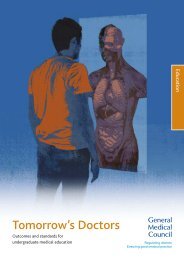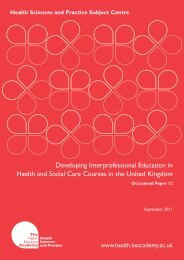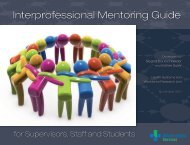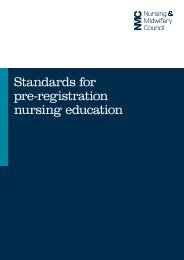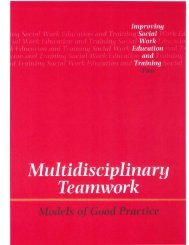(WHO) Patient Safety Curriculum Guide - CAIPE
(WHO) Patient Safety Curriculum Guide - CAIPE
(WHO) Patient Safety Curriculum Guide - CAIPE
You also want an ePaper? Increase the reach of your titles
YUMPU automatically turns print PDFs into web optimized ePapers that Google loves.
2. additional searching for content and<br />
assignment of knowledge, skills, behaviours<br />
and attitudes;<br />
3. development of performance-based format.<br />
Since the publication of the Australian <strong>Patient</strong><br />
<strong>Safety</strong> Education Framework in 2005, Canada<br />
released a framework entitled ‘The <strong>Safety</strong><br />
Competencies- Enhancing patient safety across<br />
the health professions’ in 2009 [2]. Similar<br />
to the Australian approach, it provides an<br />
interprofessional, practical and useful patient<br />
safety framework that identifies the knowledge,<br />
skills, and attitudes required by all health-care<br />
professionals.<br />
Figure A.2.2. The Canadian Framework<br />
The <strong>Safety</strong> Competencies – Enhancing patient safety across the health professions<br />
Domain 1<br />
Contribute to a Culture<br />
of <strong>Patient</strong> <strong>Safety</strong><br />
Domain 2<br />
Work in<br />
Teams<br />
for <strong>Patient</strong> <strong>Safety</strong><br />
Domain 3<br />
Communicate Effectively<br />
for <strong>Patient</strong> Sqfety<br />
Domain 4<br />
Manage<br />
<strong>Safety</strong> Risks<br />
Domain 5<br />
Optimize Human<br />
and Environmental<br />
Factors<br />
Domain 6<br />
Recognize,<br />
Respond to and<br />
Disclose Adverse<br />
Events<br />
Source: The <strong>Safety</strong> Competencies, Canadian <strong>Patient</strong> <strong>Safety</strong> Institute, 2009 [2].<br />
Stage 1–Review of knowledge and development<br />
of the Australian Framework outline<br />
A search was conducted to identify the current<br />
body of knowledge relating to patient safety<br />
(as described in the next section). The literature,<br />
books, reports, curricula and web sites collected<br />
were then reviewed to identify the major activities<br />
associated with patient safety that had a positive<br />
effect on quality and safety. These activities were<br />
then grouped into categories termed “learning<br />
areas”. Each learning area was analysed and<br />
further broken down into major subject areas,<br />
termed “learning topics”. See below for details<br />
of the literature review process and the<br />
Framework content structure.<br />
The rationale for the inclusion of each learning<br />
area and topic has been articulated in the body<br />
of the Framework and is summarized below.<br />
Stage 2–Additional searching for content<br />
and assignment of knowledge, skills, behaviours<br />
and attitudes<br />
Each learning topic formed the basis for a more<br />
extensive search, including additional terms<br />
such as education, programmes, training,<br />
adverse events, errors, mistakes, and organization<br />
/institution/health facility/health service.<br />
All the activities (knowledge, skills, behaviours<br />
and attitudes) for each topic were listed until<br />
no more activities were forthcoming and<br />
the sources exhausted. This list was then<br />
culled for duplication, practicality and<br />
redundancy. The activities were then categorized<br />
into the domains of knowledge, skills or<br />
behaviours.<br />
The final step in this stage was to allocate each<br />
activity to the appropriate level corresponding<br />
27 Part A 2. How were the <strong>Curriculum</strong> <strong>Guide</strong> topics selected?




